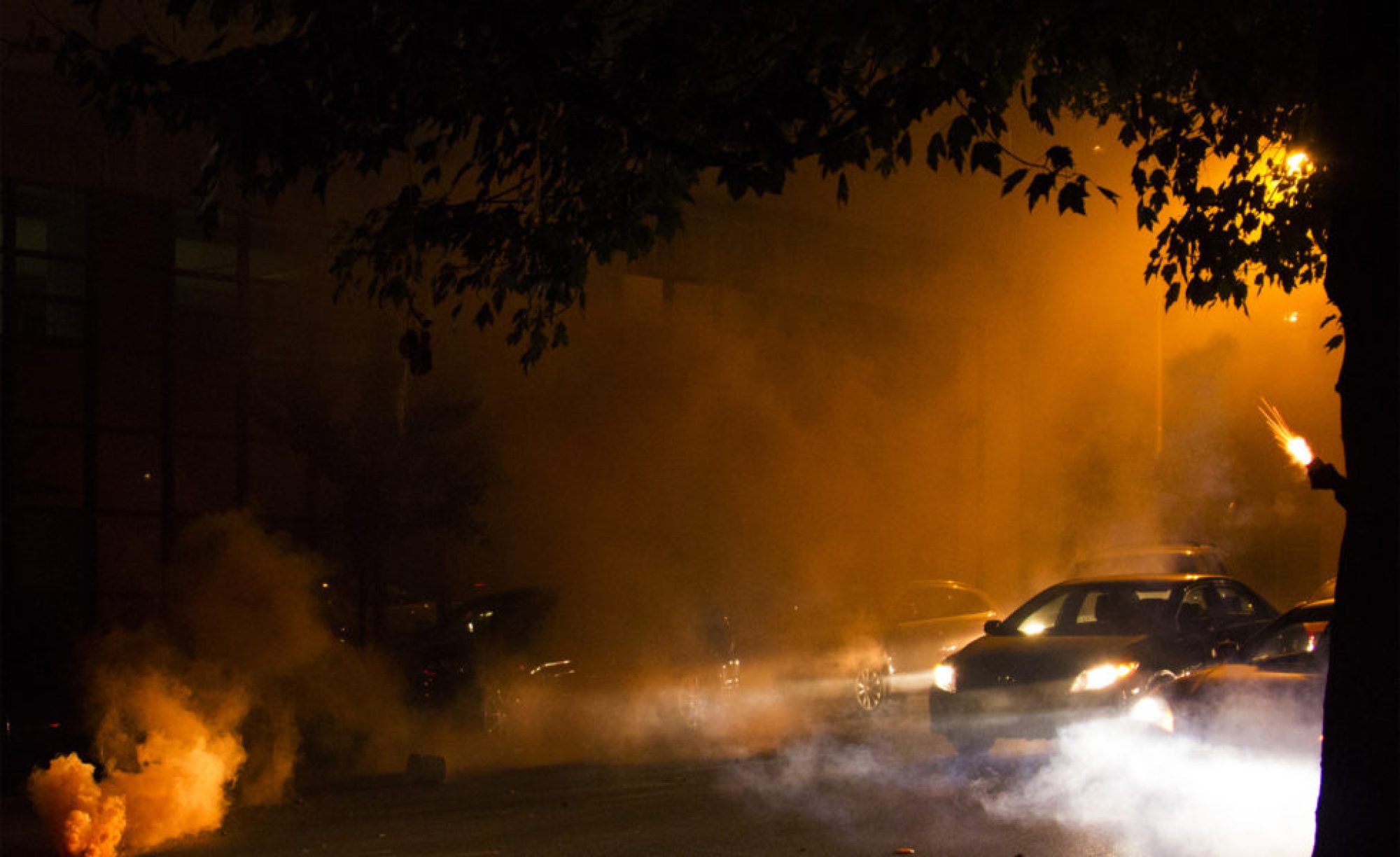
From 1890’s Spain to present day Bloomington, anarchists of varying stripes organize ourselves and take action together in what’s called an “affinity group.” Central to anarchy is not only respect for autonomy, but the belief that without stifling systems of control, people are capable of creativity, beauty, and courage. Because it is flexible, leaderless, and informal, the affinity group is one way to facilitate these drives.
In light of there being so many formal organizations with acronyms in Bloomington, I’m writing this piece hoping to encourage people to act with those they trust on their own initiative, and be skeptical of joining preexisting groups, because I believe “joining” hinders creativity and the blossoming of self-initiative.
An affinity group is an informal convergence of people who choose to struggle together, usually consisting of two to ten people. “Affinity” means closeness. Those who form an affinity group often share ideas, strategies, and goals. The uniqueness of each group means that they follow paths of their own choosing, experimenting with actions that are specific to their shared skills and desires without seeking permission from a larger decision-making body. If affinities weaken, people will leave the group or choose to dissolve it altogether. There are no membership lists, and the organization of the group is minimal. People come together as an affinity group to act, not to grow the group through recruitment. In fact, the label “affinity group” makes it seem more formal than it actually is: a more fitting name would be “crew.” An affinity group doesn’t even have to be political: bands and sewing circles are examples of affinity groups.
Affinity groups are simple, they are a vehicle for like-minded people to do things together. Things such as wheatpasting propaganda around town, reading and discussing texts, navigating a demonstration, sabotaging gentrification efforts, learning a skill together, or working on a publication. The basic formula for being in one is to feel out your desires, talk with your comrades, survey the situations you’re in, and take action or form projects that make sense to you. When the focus is explicitly not to recruit, a whole world of possibilities opens up, and you begin to realize that you have more power than you previously thought. While it is certainly true that there’s power in numbers, there’s also power in confidence, self-initiative, courage, and the bonds that come from shared experiences in the streets. A large mass of people may actually be significantly less capable than a small affinity group, simply because people in the latter learn to be strategic with their small numbers and are aware of their capacity together.
Affinity groups can exist for a long time or form temporarily to accomplish one task: for example hanging a banner from a highway overpass or removing police barricades during a demonstration. Whether they’re long-term or short-term, a key element in forming an affinity group is trust. If you’re planning to do illegal things together, you definitely should make sure you trust the people you’re doing them with and know how they act under pressure. When doing illegal things, it’s best to operate on a “need-to-know” basis. An affinity group conspires together, figures out logistics, and does the thing. There’s no need for others to know. This helps keep repression and potential damage from informers to a minimum. That anarchist networks are informal also makes it hard for state investigators to map them out.
The flexible structure and emphasis on trust and action is intentionally there to prevent some trappings that political groups often fall into. People with radical politics first think to join a formal organization with a name that sounds like something they’d be into. Usually when working in such groups, they end up spending a lot of time and energy for the sake of the organization itself, instead of working on the goals it claims in its charter or points of unity. Bureaucracies work in this way: the number one priority is always for the organization to continue existing; and everything else is subordinate to and structured by that. Contrastingly, affinity groups are structured to facilitate action; it doesn’t matter if the group exists or not, the affinity group is tool belonging to people with shared ideals and goals, not the other way around.
This society does not create people who are experienced in taking initiative, who have healthy methods of engaging in conflict with each other, and who are in touch with what they want. Instead, it promotes obedience, passivity, apathy, and toxic social relationships. Being in the ranks of hierarchical political parties or mass-based groups where decisions go through a democratic bottleneck does not encourage liberation. These groups require their participants follow orders just as much as bosses and cops do, and promote thinking as much as watching television does.
Massive general assemblies (like those during the Occupy movement) that act as decision-making bodies discourage individuals or small groups from taking action on their own. Since decisions must be agreed upon in the General Assembly, the initiatives agreed upon are those that ruffle the least feathers, often the most conservative and banal. The only creativity channeled is that of manipulation, a talent needed by competing sects trying to wrestle control of the GA through slimy political maneuvering. A similar dynamic happened to Students for a Democratic Society (SDS) in the late ‘60s and again in the 2000s, a true testament to democratic society.
When coordination is needed on a larger scale, affinity groups strategize and work together. One model for this is the “spokes-council” where affinity groups converge for discussion, each appointing one person to temporarily represent their group. The spokes-council is not a decision-making body, so it doesn’t come to any binding conclusions that each affinity group is expected to follow. Usually what happens is that affinity groups have pre-formulated proposals for action to give at the meeting: they describe what they plan to do or what they think should happen, and then discussion follows. Those ultimately interested in the proposal will likely meet together afterwards to plan logistics, while those who are uninterested will make their own plans accordingly.
This formula works in some situations, like when there are multiple, experienced affinity groups involved, but it’s not always appropriate. Anarchists in the U.S. have tried borrowing some of these methods to create open assemblies that anyone can attend under similar pretenses. A recent example of this were the daily assemblies anarchists in Bloomington called for during the September 2016 U.S. Prison Strike. The assemblies were advertised around town and on the internet, and it was made clear that anyone interested in taking action in solidarity with the strike could attend. While actions did eventually come from those assemblies, the problem was that most people attending did not have affinity groups or proposals to give. That many people don’t organize and take action in this way was something that those who called for the assemblies didn’t anticipate.
It’s not always possible for someone to form an affinity group, since the model relies on one having people in their life with shared beliefs who want to take action together. People newly interested in radical politics often come to these ideas on their own and/or through the internet, and look for established formal organizations to find people who share them. Nevertheless, even if not everyone can form one for themselves, these underlying ideas and critiques are important to consider when thinking about taking action and working on projects.
Suggested further reading:
- Good Manners and Affinity Groups
- Together: Booklet to Form Affinity Groups
- How to Form an Affinity Group
- Insurrectionary Anarchism
